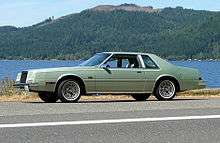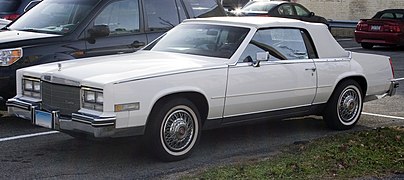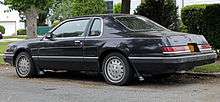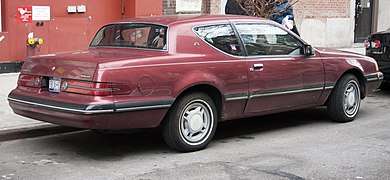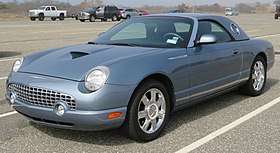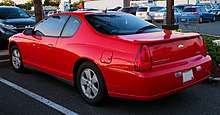Personal luxury car
Personal luxury car is a North American car classification describing somewhat sporty, sophisticated coupes that emphasized comfort over performance.[1] The North American manufacturers most often combined engineering, design, and marketing to develop upscale, distinctive "platform sharing" models that became highly profitable.[2]
Although mass-market luxury coupes had been produced in North America for several decades previously, the beginning of the "personal luxury car" genre is generally considered to have started in 1958,[3] due to the success of the Ford Thunderbird (second generation) when it was redesigned from a two-seat car to a four-seat car.[4][5][6][7] These changes shifted the Thunderbird's emphasis from sporting to comfort and luxury, and sales increased by 50 percent.[3] The Thunderbird was sold for eleven generations up until the 2005 model year.
The longest running nameplate of personal luxury car was the 50 year run of Cadillac Eldorado, which started in the 1953 model year, originally designating low volume versions of lower priced Cadillac models, including the hand-built four door 1957 Eldorado Brougham. According to Hemmings Motor News, Cadillac first entered the "personal luxury car" market in 1967, with a smaller high volume model.[8]
Prior to the late 1970s, personal luxury cars were usually large, rear-wheel drive vehicles powered by large V8 engines. As a result of the downsizing trend in the American automotive industry during the late 1970s, many personal luxury cars have been produced as mid-size cars with six-cylinder engines and front-wheel drive. By the 21st century, the personal luxury market had largely disappeared as consumers migrated to other market segments.
Characteristics
The body style was typically a two-door coupé or convertible, with either no rear seat or a small rear seat not intended for regular use by adults. Personal luxury cars were designed for the comfort and convenience, so they were often highly equipped with interior features that were either optional or not available on other models.[9]
Although they often used large engines, overall performance was often blunted by the mass of the car. The cars were usually mass-produced and often shared major mechanical components with other models from the manufacturer to reduce production costs.[2]
The styling of 1950s personal luxury cars has been described as a "baroque excess".[10]
History
1950s

.jpg)

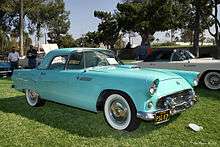
Low Volume - Premium
The first personal luxury cars were expensive, low volume vehicles. These included the Cadillac Eldorado,[11][12][13] Buick Roadmaster Skylark, Oldsmobile 98 Fiesta and Packard Caribbean. All four models were released in 1953 with a convertible body style and powered by V8 engines. The Eldorado was based on the Cadillac Series 62 and cost US$7,750, almost twice the price of a base model Series 62.[14] It represented 0.5% of Cadillac's total sales in 1953. The Buick Roadmaster Skylark was priced at over US$5,000, an increase of 50% compared to the standard Buick Roadmaster convertible.[14] There were 1,690 Skylarks sold over its two years of production. The Oldsmobile 98 Fiesta was released in the final year of production for the third-generation Oldmobile 98. Priced at US$5,715 (almost twice the price of a standard Oldmobile 98), there were 458 Fiesta's sold during the single year of its production. The Packard Caribbean's production total for 1953 was 750 cars.
The 1955 Imperial Newport was a two-door hardtop built on a platform shared with the less expensive Chrysler New Yorker and Chrysler Windsor.
Ford released the Continental Mark II for the 1956 model year. With a price of approximately US$10,000, the cost was equivalent to a Rolls-Royce and 3,012 Mark IIs were sold from 1955 to 1957.[15] It was produced in the two-door hardtop body style and standard equipment included power steering, power brakes, power windows, power seats, power vent windows, leather interior and a tachometer. The only option was air conditioning for $595.[16]
High Volume - Mass Market
The Ford Thunderbird, released in 1955, was marketed as a personal car [17] and is often credited with playing a key role in the creation of the personal luxury car segment.[18][19][20] The first-generation Thunderbird was a two-seat car with a V8 engine, suspension which was designed for comfort instead of handling and available in convertible (folding soft-top) and roadster (removable hardtop) body styles.[5]
The 1958 Ford Thunderbird was the first high volume personal luxury car. It added a rear seat, in response to Ford's market research that the two-seat layout of the first generation was limiting sales. The convertible/roadster body style was replaced by two models, a fixed hardtop and convertible.[21] Sales totalled approximately 200,000 over three years, approximately four times that of the earlier two seat model. [5][6][21] The Thunderbird received the 1958 Motor Trend Car of the Year award.[6]
1960s
.jpg)
.jpg)

.jpg)
.jpg)
Two competitors inspired by the continued marketplace success of the four seat Thunderbird appeared for model year 1963, both shown at the October 1962 Paris Motor Show. [22] Both followed the close coupled four seater coupe with powerful engine formula, laid down by the 1958 Thunderbird. [23]
The first was the Studebaker Avanti. The Avanti featured a fibreglass body, an optional supercharged engine and front disc brakes. It was marketed as "America's only 4 passenger high-performance personal car".[24] The company built 4,647 Avantis before Studebaker folded in 1963.[25][26]
The second was the 1963 Buick Riviera, which began life as the Cadillac LaSalle XP-715 concept car. [22] However, General Motors management was not interested in the XP-715 concept for Cadillac and offered it up to a competition between interested divisions. Buick won based on its marketing presentation.[27][28][29] Total sales for the 1963–1965 model years was 112,244. [23]
AMC's first personal luxury car was the intermediate-sized 1965 Rambler Marlin.[30] The Marlin was described as "unusual, distinctive and in a class by itself".[31]
The 1966 Oldsmobile Toronado became the first front-wheel drive personal luxury car. The Toronado provided the platform for the Cadillac Eldorado (sixth generation) to switch to a smaller high volume 'personal luxury' front-wheel drive layout the following year.[8]
Up until 1967, personal luxury cars were grouped together with muscle cars and pony cars as the "specialty cars" classification.[32] Rather than marketing to broad income classes as with their standard models, each of these car classes was targeted by the automakers to smaller and more specific market niches while offering long lists of options to satisfy consumer demands for individuality.[33]
For 1967, the Rambler Marlin (second generation) moved from a mid-size to a full size platform as a "larger 3+3 family coupe designed to appeal to the market’s trend toward bigger cars with more appointments."[34] Also for 1967, the Ford Thunderbird (fifth generation) was released, moving further upmarket and with a four-door pillarless hardtop body style being added.[30]
The Continental Mark III two-door coupe was introduced for the 1969 model year as the flagship vehicle of Ford Motor Company and as a successor to the 1956–1957 Continental Mark II. To lower development costs, the Mark III was based upon the chassis of the Ford Thunderbird (fifth generation). Styling features of the Mark III included hidden headlamps (with retractable body-colored covers), a Rolls Royce style grille, and a simulated spare tire on the trunklid. The Mark III was the first American-made vehicle with radial tires as standard equipment.[35]
In what would become a three-decade rivalry, the Mark III quickly outsold its direct competitor, the Cadillac Eldorado.
The Mercury Marauder (second generation) was released for 1969 as its own model line of personal luxury cars. The Marauder used a shorter wheelbase than the full-sized Mercury models, weighed 4,500 lb (2,000 kg), was powered by a 429 cu in (7.0 L) V8 engine and used bias-ply whitewall tires on five-spoke aluminum wheels.[36]
Also for 1969, the Pontiac Grand Prix (second generation) downsized from being a full-size to a mid-size coupe, in an attempt to reverse the declining sales of the Grand Prix model. Smaller than the Cadillac Eldorado and Oldsmobile Toronado, it was designed to be nimbler and more performance oriented than the smaller Ford Thunderbird and Buick Riviera. Sales reached over 112,000 units, almost quadruple the 32,000 full-sized models built in 1968.
1970s
The decline of the muscle car, due to rising insurance costs and emissions standards in the early 1970s, coincided with a strong upswing in the personal luxury segment, as American buyers shifted emphasis from performance to comfort.[37] Offsetting this, the 1973 and 1979 oil crises impacted demand for cars with relatively poor fuel economy.[38] The 1970s personal luxury models were marketed on the basis of luxury, not performance.[39] They were conventional in design and shared many parts with lesser models.[39]
Due to the success of the 1969 Pontiac Grand Prix, other GM divisions followed suit and introduced similar cars for 1970. The Chevrolet Monte Carlo— considered an upscale vehicle for GM's lowest-priced division— was slightly shorter than the Grand Prix, due to being built on the Chevrolet Chevelle platform.[40] The Monte Carlo was marketed as providing "elegance and prestige", however some reviewers found it more similar to Chevrolet's more utilitarian models.[41] The coupe model of the downsized Oldsmobile Cutlass Supreme was introduced for 1970 and was sold alongside the larger Oldsmobile Toronado. The base price of the Monte Carlo and Cutlass Supreme were much lower than the Grand Prix, however all three models were similar in price if they were ordered with the same level of equipment. Nonetheless, it is claimed that Chevrolet and Pontiac "took personal luxury cars to the masses".[42] The introduction of the Monte Carlo and Cutlass Supreme did cut into the Grand Prix's dominance, and sales dropped 40%.
The 1972 Ford Thunderbird (sixth generation) had a significant increase in size over the previous generation, making it larger than most other personal luxury cars. The 1974 Mercury Cougar XR-7 was upsized to an intermediate platform (shared with the Ford Torino and Mercury Montego),[43] since the Mustang was downsized to become the subcompact Mustang II for 1974, leaving the Cougar XR-7 without a platform mate. The Cougar XR-7 was also sold as the 1974–1976 Ford Elite, which was styled to resemble the Thunderbird and marketed at a lower price.[44] The Cougar XR-7 was priced higher than the Elite and included more standard features, but sold about 60,000 units compared to almost 125,000 Elites for the 1975 model year.[44]
Mercedes-Benz took advantage of this American consumer trend during this era, with its 450SL and SLC models, beginning in 1972.[45][46] North America was the key market for these models, and 2/3 of production was sold there.[47] Mercedes-Benz were coy in their American ad copy about the car being a sports car, advising potential buyers "Spoil Yourself" and asking “How can a 2-seater weighing 3,500 pounds loaded down with an automatic transmission and luxury power amenities be considered a sports car?.” [48] The 450SL addressed the same market niche as the 1955-57 two-seat Ford Thunderbird personal car, which had similar categorization issues.[48] [49]
The mid-size Chrysler Cordoba was introduced for 1975 as the company's first coupe produced specifically for the personal luxury market[50] (despite the company declaring earlier that there would "never be a smaller Chrysler"). The Cordoba used vintage styling cues like Rolls Royce-style radiator grilles, opera windows, and vinyl roofs. By 1975, other models which had entered the personal luxury car segment included the AMC Matador (second generation), Buick Regal, Dodge Charger (fourth generation). The two highest selling personal luxury cars for 1975 were the Chevrolet Monte Carlo and the Chrysler Cordoba.[51]
In the mid-1970s, luxury features were becoming more common on compact and subcompact cars. The 1978 Plymouth Sapporo coupe (a rebadged Mitsubishi Galant Lambda built in Japan) was marketed as a personal luxury car,[52][53] featuring a vinyl roof with a stainless steel targa band, velour interior, "luxury" wheel covers with whitewall tires, and various power accessories.
For the 1977 model year, the Ford Thunderbird (seventh generation) was downsized to an intermediate-size platform (based on the Ford LTD II), shedding nearly 10 inches (254 mm) of length and 900 lb (408 kg) of weight. It was repositioned as the replacement for the Ford Elite and sold alongside the closely related Mercury Cougar (fourth generation). The Thunderbird was assembled using a mix of body, interior and trim parts from the previous year's Ford Elite, Mercury Montego and Mercury Cougar, plus unique styling for the rear bodywork. This generation became the best selling in the history of the Ford Thunderbird. Helped by a $2,700 drop in price from 1976, over 318,000 sold in 1977 and 352,000 in 1978 (the best single sales year in Thunderbird history), followed by 295,000 in 1979. [54]
The 1978 Buick Regal, Chevrolet Monte Carlo, Oldsmobile Cutlass Supreme and the Pontiac Grand Prix were among the first of the personal luxury cars to be radically downsized, resulting in weight reductions of more than 900 pounds (408 kg)[55] and exterior dimensions similar to compact cars (e.g. the Chevrolet Nova, Ford Granada and Dodge Dart).
For 1979, Cadillac Eldorado (eighth generation), Buick Riviera (sixth generation) and Oldsmobile Toronado (third generation) were downsized to an intermediate-sized front-wheel drive platform, resulting in a 20 in (508 mm) reduction in length in the case of the Eldorado. Engines were also downsized, with V6 engines available for the first time in these models history. The Riviera was awarded Motor Trend Car of the Year in 1979. Sales more than doubled, to 52,181 for 1979 and 48,621 for the very similar 1980 models.[56]
1980s
Throughout the 1970s, American built personal luxury cars had grown heavier and more luxurious, resulting in heavier cars. However engine power had reduced as a result of either downsizing to six-cylinder engines or detuning the V8 engines in order to comply with increasingly strict vehicle emissions standards. Along with the reduced straight-line performance, the cars also had poor fuel economy and were battling against the industry trend towards smaller cars.
The Chrysler Cordoba (second generation) debuted for 1980 and sales fell substantially. It was discontinued in 1983. The 1980 Imperial (sixth generation), which was built on the Cordoba chassis and marked a key milestone in the decline of the personal luxury car. The 318 cu in (5.2 L) V8 engine produced only 140 hp (104 kW),[57] pricing was 200% higher than the standard Chrysler K platform, the reaction in the motoring press was especially vicious and sales were poor.[58][59]
The 1980 Ford Thunderbird (eighth generation) and Mercury Cougar (fifth generation) were downsized to a mid-size car and described as "stodgy-looking".[60] Sales were drastically reduced,[55] resulting in extensive revisions for the 1983 model year. While remaining a personal luxury coupe, the redesign of the Thunderbird and Cougar introduced highly aerodynamic body design to Ford vehicles in North America and significantly increased sales.[61][62]
In 1981, sales of the Cadillac Eldorado (eighth generation) were down 40% and Continental Mark VI were down 50%.[58]
For the 1984 model year, Continental Mark VII was downsized to a mid-size car, based on a platform shared with the Ford Thunderbird and Mercury Cougar.
For 1986, General Motors drastically downsized the Cadillac Eldorado (ninth generation), Buick Riviera (seventh generation) and Oldsmobile Toronado (fourth generation) by 13–16 in (330–406 mm). With a sales drop of 60%, seldom has any model experienced such a dramatic fall in sales. The Riviera and Toronado used Buick's 232 cu in (3.8 L) V6 engine, while Cadillac continued to use their 250 cu in (4.1 L) V8 engine. The Eldorado's convertible body style was discontinued and replaced with the Cadillac Allanté luxury roadster. The base price of the 1986 Eldorado increased by approximately 16% to $24,251 and production was reduced to about a quarter of what it had been just two years earlier. Similarly, the 1986 Riviera's base price increased substantially to $19,831, and sales plummeted to 22,138 for 1986, only 15,223 for 1987, and 8,625 for 1988 (although the 1988 introduction of the Buick Reatta coupe may have cannibalized some Riviera sales that year).
The final year of production for the rear-wheel-drive Oldsmobile Cutlass Supreme (fourth generation) was 1988, during which 27,678 were built.[63]
For 1988, GM moved the Buick Regal, Oldsmobile Cutlass Supreme and Pontiac Grand Prix to versions based on GMs front-wheel-drive W-body platform. The Chevrolet Monte Carlo was discontinued after a short 1988 model year run (replaced by the 1990 Chevrolet Lumina mid-size coupe).[64] With the discontinuation of the Chevrolet Celebrity and Pontiac 6000, the Regal, Cutlass Supreme and Grand Prix moved from the personal luxury segment to the conventional mid-size segment, and were also offered in the 4-door body style.
1990s

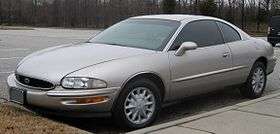
In the early 1990s the trend towards four door sedans and SUVs caused the market for personal luxury cars to decline. The Oldsmobile Toronado was discontinued in 1992. The Ford Thunderbird and Mercury Cougar were discontinued after the 1997 model year (although the Cougar nameplate was revived for 1999 as a mid-size sport compact).
The Lincoln Mark VIII, introduced for 1993, was discontinued in 1998, thereby ending the Mark series. Total production of Mark VIII was slightly more than 126,000 units.[65] General Motors ended production of the Buick Riviera in 1998, with 1,956 cars produced in the final model year.
For 1995, the Chevrolet Monte Carlo was re-introduced, built on the front-wheel drive GM W-body platform. It was essentially the two-door coupe version of the updated Lumina four-door sedan replacing the previous year's Lumina two-door coupe. [66]
2000s
In 2001, General Motors announced that the Eldorado's 50th model year (2002) would be its last. To mark the end of the nameplate, a limited production run of 1,596 cars were produced in red or white—the colors available on the original 1953 convertible. Production ended on April 22, 2002[67] with the Lansing Craft Centre retooled to build the Chevrolet SSR.
The Ford Thunderbird (eleventh generation) was produced for the 2002 to 2005 model years. It retained the traditional rear-wheel drive layout and was based on the Ford DEW platform. With styling cues from the original 1955–1957 Thunderbird, it was part of an early-2000s retro styling trend that included the Volkswagen New Beetle, Chrysler PT Cruiser, Plymouth/Chrysler Prowler and Mini Hatch. It was initially well received by the automotive press, garnering accolades such as the Motor Trend Car of the Year and a nomination for the North American Car of the Year in its first year. However, many publications regarded the Thunderbird's revival rather more frostily after a few years and it garnered a place on Car and Driver magazine's 2009 list of "The 10 Most Embarrassing Award Winners in Automotive History".[68] Sales did not meet Ford's expectations and the Thunderbird was discontinued in 2005.
The 2000 Chevrolet Monte Carlo (sixth generation) was also influenced by the retro trend, incorporating styling cues its 1970s and 1980s predecessors. The Monte Carlo was the final personal luxury car in production when it was discontinued at the end of the 2007 model year.[69]
See also
- Coupé
- Convertible
- Grand tourer
- Luxury car
- Malaise era
- Muscle car
References
- Fitzgerald, Craig (September 2019). "Personal Luxury Coupes of the 1960s and 1970s". BestRide. Retrieved October 24, 2019.
- Koscs, Jim (January 8, 2014). "Instant Car-ma: How Detroit created the 'personal luxury' boom on the cheap". Hagerty. Retrieved October 24, 2019.
- Gartman, David (1994). Auto opium: a social history of American automobile design. Taylor & Francis. p. 180. ISBN 978-0-415-10572-9.
- Genat, Robert (2006). Hemi Muscle. Motorbooks. p. 62. ISBN 9780760326787. Retrieved July 31, 2015.
- Koscs, Jim (May 23, 2016). "Other Perspectives: what is a Thunderbird". AutomotiveMileposts.com. Retrieved August 20, 2016.
- "1958 Ford Thunderbird: Personal Luxury 101". AutomotiveMileposts.com. Retrieved August 20, 2016.
- Vaughan, Daniel (March 23, 2006). "1958 Ford Thunderbird". Conceptcarz.com. Retrieved May 10, 2019.
- McGean, Terry (December 2010). "1967 Cadillac Eldorado THIS ELEGANT PERSONAL LUXURY COUPE REMAINS AFFORDABLE". Hemmings.com. Retrieved March 10, 2020.
- "1964 Pontiac Grand Prix". www.hemmings.com. Retrieved February 16, 2019.
- Harless, Robert (2004). Horsepower War: Our Way of Life. iUniverse. p. 193. ISBN 0-595-30296-3.
- "1953 Cadillac Eldorado". www.topspeed.com. Retrieved February 20, 2019.
- "Forgotten Luxury: 20 Best American Personal Luxury Coupes and Convertibles". www.motor-junkie.com. June 26, 2018. Retrieved February 20, 2019.
- "Personal Luxury: The Cadillac Eldorado". www.fossilcars.com. September 7, 2010. Retrieved February 20, 2019.
- Flory, Jr., J. "Kelly" (2008). American Cars, 1946–1959 Every Model Every Year. McFarland & Company, Inc., Publishers. ISBN 978-0-7864-3229-5.
- Auto Editors of Consumer Guide (October 31, 2007). "1956 Continental Mark II Convertible". Auto.howstuffworks.com. Retrieved March 23, 2018.
- Flory, Jr., J. "Kelly" (2008). American Cars, 1946–1959 Every Model Every Year. McFarland. ISBN 978-0-7864-3229-5.
- "1955 Ford Thunderbird – A personal car of distinction". AutomotiveMileposts.com. Retrieved August 20, 2016.
- "Blue Oval Icons: History of the Ford Thunderbird". www.fordmuscle.com. December 1, 2018. Retrieved February 20, 2019.
- "Marilyn Monroe's Personal Ford Thunderbird Is Going to Auction". www.thedrive.com. Retrieved February 20, 2019.
- "History of the Ford Thunderbird". www.ctci.org. Retrieved February 20, 2019.
- Mueller, Mike; Batio, Christopher (1999). Thunderbird Milestones. MotorBooks/MBI Publishing. p. 38. ISBN 978-0-7603-0474-7. Retrieved July 31, 2015.
- Phil Patton (October 5, 2012). "Riviera, a Clean Break for G.M., Is Still Fashionable at 50". New York Times. Retrieved June 1, 2019.
- Mike McKnessor (August 2013). "1963-1965 Buick Riviera ONE OF GM'S MOST STYLISH POST-WAR DESIGNS IS STILL TURNING HEADS". Hemmings Motor News. Retrieved June 1, 2019.
- "Studebaker: Different by Design". oldcarbrochures.org (Sales brochure). 1963. p. 10. P.D.-64-11. Retrieved March 23, 2018.
- "Production Statistics for the Studebaker Avanti". www.studebaker-info.org. Retrieved March 23, 2018.
- Hays, Ed (May 2009). "Welcome to the Family Studebaker-Packard, meet Mercedes-Benz". Hemmings Motor News. Retrieved March 23, 2018.
- "Cadillac Personal Luxury Car Concepts". Car Design News. Retrieved February 23, 2019.
- "1961 Cadillac LaSalle XP-715". Automobile Brands of the Past. Retrieved February 23, 2019.
- Horses to Horsepower: The second 50 years, 1946–1996. McVey Marketing. 1996. p. 43. Retrieved July 31, 2015.
- "Why auto prices are going up". U.S. News & World Report. Vol. 61. 1966. p. 85.
- "Marlin". Cars & Parts. Amos Press. 36: 22. 1993. Retrieved February 14, 2011.
- "Specialty Cars In Industry Spotlight". Ward's Automotive Yearbook, Volume 29. 1967. p. 116. Retrieved July 31, 2015.
- Gartman, David (2013). Culture, class, and critical theory: between Bourdieu and the Frankfurt school. Routledge. p. 116. ISBN 9780415524209. Retrieved March 23, 2018.
- Rood, Eric (August 23, 2016). "Cars You Should Know: A Brief History Of The AMC Marlin". Roadkill. Retrieved March 23, 2018.
- Vaughan, Daniel (September 2008). "1969 Lincoln Continental Pictures, History, Value, Research, News". conceptcarz. Retrieved November 29, 2017.
- Spinelli, Mike (May 6, 2011). "What's the ultimate "personal luxury" car?". Jalopnik. Retrieved March 23, 2018.
- Tarasi, Jason. "The Rise And Fall Of The Muscle Car Era". streetdirectory.com. Retrieved November 29, 2017.
- Treece, James (October 14, 2013). "10 ways the 1973 oil embargo changed the industry". Autoweek. Retrieved July 1, 2016.
- DeMauro, Thomas A. (October 31, 2016). "10 reasons to consider a 1970s personal/luxury coupe for your next weekend cruiser". Hemmings. Retrieved March 23, 2018.
- McIntosh, Dale (2016). Chevelle Data & ID Guide: Includes Wagons, El Camino and Monte Carlo Models. CarTech. p. 184. ISBN 9781613252987. Retrieved November 29, 2017.
- "The 70 cars: the really new ones". Popular Mechanics. 132 (4): 108. October 1969. Retrieved July 31, 2015.
- "Would you buy a used car?". Motor Trend. 37: 72. 1982. Retrieved July 31, 2015.
- Gunnell, John (2004). Standard Catalog of Thunderbird: 1955–2004. Krause Publications. p. 110. ISBN 978-0-87349-756-5. Retrieved July 31, 2015.
- Appel, Tom (February 13, 2014). "Our Apologies: The Personal Luxury Cars of 1975". The Daily Drive – Consumer Guide. Retrieved March 23, 2018.
- Gilboy, James (October 9, 2019). "Elvis Presley's 1974 Mercedes-Benz 450 SLC Expected to Fetch $200,000 at Auction - This Merc was supposedly The King of Rock and Roll's choice when he wanted to drive around incognito". TheDrive.com. Retrieved May 8, 2020.
- Johnson, Carter (November 25, 2016). "The Big, Bad, Automatic Benz that Took on the WRC - the C107". TheDrive.com. Retrieved May 8, 2020.
- https://media.daimler.com/dcmedia/0-921-657476-1-1279283-1-0-0-0-0-1-0-0-0-1-0-0-0-0-0.html Daimler.com Retrieved 11 May 2016
- Conner, Sean (June 22, 2015). "The classic 1972 – 1989 Mercedes SL spanned 18 model years without one body panel change". Classic Cars Online. Retrieved May 8, 2020.
- Rala, James (February 24, 2011). "Ford Thunderbird (two-seater), 1955-57 car review". Weekly Driver. Retrieved May 8, 2020.
- Hyde, Charles K. (2003). Riding the Roller Coaster: A History of the Chrysler Corporation. Wayne State University Press. p. 223. ISBN 978-0-8143-3091-3. Retrieved July 31, 2015.
- Flory, Jr., J. "Kelly" (2008). American Cars, 1973–1980 Every Model Every Year. McFarland. p. 364. ISBN 9780786432295. Retrieved July 31, 2015.
- "Lost Cars of the 1980s – Dodge Challenger and Plymouth Sapporo". www.hemmings.com. Retrieved February 24, 2019.
- "Plymouth Sapporo emerges from time portal and lands on Craigslist". www.autoweek.com. Retrieved February 24, 2019.
- Katz, John F. (1989). Soaring Spirit: Thirty-five Years of the Ford Thunderbird. Kutztown, Pennsylvania: Automotive Quarterly, Inc. pp. 44. ISBN 0915038676.
- Appel, Tom (December 23, 2014). "Smaller Still: The Personal Luxury Cars of 1980". The Daily Drive – Consumer Guide. Retrieved March 23, 2018.
- "Evolution of the Riviera". Riviera Owners' Association. Retrieved February 17, 2007.
- "1982 Chrysler (USA) Imperial 14gen Coupe full range specs". www.automobile-catalog.com. Retrieved February 25, 2019.
- Severson, Aaron (November 26, 2008). "It's (Not) Time for Imperial: Chrysler's 1981–1983 Imperial Coupe". Ate Up with Motor. Retrieved August 29, 2016.
- Davis, Jr., David E. (January 1981), Chrysler Imperial: Return with us now to those thrilling days of yesteryear, Car & Driver
- Davis, Michael W. R.; Wagner, James K. (2002). Ford Dynasty: A Photographic History. Arcadia. p. 117. ISBN 9780738520391. Retrieved July 31, 2015.
- Katz, John F. (1989). Soaring Spirit: Thirty-five Years of the Ford Thunderbird. Kutztown, Pennsylvania: Automotive Quarterly, Inc. ISBN 978-0915038671.
- Tast, Alan H. and David Newhardt. THUNDERBIRD FIFTY YEARS. Motorbooks. October 15, 2004.
- Ward's Automotive Yearbook 1989. Ward's Communications, Inc. 1989.
- "Chevrolet Monte Carlo model history". NADAguides. Retrieved January 29, 2016.
- Mark VIII Production Numbers
- "Chevrolet Monte Carlo model history". NADAguides. Retrieved January 29, 2016.
- Flores, Dan (April 22, 2002). "Cadillac Commemorates the End of an Era as the Last Eldorado Rolls Off the Assembly Line". Press release. GM Media Online. Retrieved August 12, 2007.
- "Dishonorable Mention: The 10 Most Embarrassing Award Winners in Automotive History – Feature". Retrieved September 13, 2017.
- "2000-06 Chevrolet Monte Carlo – The Last Gasp Of The American Personal Luxury Coupe". www.curbsideclassic.com. Retrieved February 28, 2019.
.jpg)
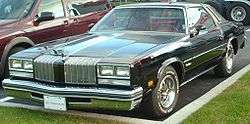
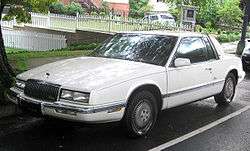
.jpg)
.jpg)
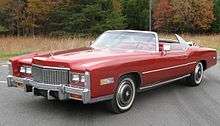
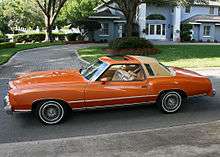
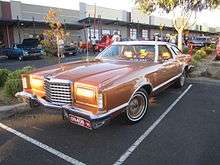
.jpg)
